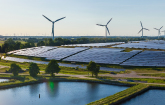BOSTON, Dec. 6, 2023 /PRNewswire/ -- On the 28th November 2023, a plane flew from London to New York. For the first time in history, this transatlantic flight was 100% powered by sustainable alternative fuels. This rounds off a promising year for sustainable fuels in aviation. Earlier in 2023, ReFuelEU Aviation Regulation was adopted by the European Union, mandating a 70% sustainable aviation fuel blending obligation by 2050.
Sustainable alternative fuels are made from any non-fossil-based renewable feedstock, including biomass, cooking oils, and CO2. They offer carbon footprint reductions compared to their fossil fuel equivalents and are carbon neutral in some cases. Since the energy densities of battery technologies are too low for full electrification of airliners to be feasible, such fuels represent the most viable pathway to decarbonize the aviation sector. Biofuels, the incumbent sustainable alternative fuel, are associated with issues such as extensive land use and competition with food production, creating an interest in CO2-derived fuels.
For further information on sustainable fuels and utilizing CO2 as a raw material, please refer to the IDTechEx sustainability reports portfolio.
What is a CO2-derived fuel?
Chemically identical to their fossil fuel counterparts, CO2-derived fuels are produced artificially using H2 and captured CO2. If the hydrogen is produced from renewable powered electrolysis, the process of making the CO2-derived fuel is known as "Power-to-Liquid (PtL)", and the fuel can be classified as an "e-fuel."
There are many different technologies for abiotically capturing the required CO2. Point source capture technologies, including liquid solvents, solid adsorbents, and membranes, are commercially available and are forecasted by IDTechEx to exceed 1 Gtpa capture capacity by 2040. Examples of point source emitters include power generation plants (where either biomass or fossil fuels are combusted) and industrial facilities (such as cement plants). Alternatively, CO2 can be captured directly from the atmosphere using DAC (direct air capture).
A variety of pathways for conversion of CO2 to fuels have been developed, including thermocatalytic, electrocatalytic, and biological conversion. Using a combination of heat, pressure, and inorganic catalysts, thermocatalytic pathways are one of the oldest and most technologically mature routes for CO2 conversion into many hydrocarbon and oxygenated products. For example, direct CO2 hydrogenation to produce methanol is already a commercial process, and companies advancing such plants worldwide include Carbon Recycling International (CRI), Liquid Wind, and ABEL Energy. More information on this synthesis can be found in the IDTechEx Carbon Dioxide Utilization 2022-2042: Technologies, Market Forecasts, and Players report.
Production of CO2-fuels promises a route to carbon-neutral fuels with little to no adaptations to the existing infrastructure and stock of vehicles. However, large amounts of external energy are required to convert the stable CO2 molecule into an energy-rich fuel. This means the rollout of CO2-derived fuels will depend heavily on abundant renewable power sources.
Can other transport sectors benefit from CO2-derived fuels?
Aviation is not the only transport sector that needs to decarbonize. Global GHG emissions from shipping account for almost 1 billion metric tons of CO2 annually (3% of global emissions). Alongside green ammonia, CO2-derived methanol is regarded as one of the leading maritime renewable fuel options to achieve carbon neutrality.
e-Methanol has a superior volumetric energy density and storability compared to batteries or H2, and it is combusted more efficiently than regular fuels. Maritime industry leaders are already ordering methanol-fueled vessels as part of their decarbonization strategies. In 2021, Maersk ordered the world's first methanol-enabled container vessel. As of June 2023, over 100 marine vessels with the ability to run on methanol had been ordered worldwide (with Maersk itself having 25 methanol-enabled vessels on order). This uptake has been partially driven by the inclusion of shipping in the EU ETS from January 2024.
Currently, two major (methanol output exceeds 100 ktpa) CO2-derived methanol plants are operational, both based in China and both using CRI technology. Europe is poised to become the dominant CO2-derived methanol producer by 2026 because of projects such as Finnfjord and FlagshipTWO.
What about cars?
Full electrification of the aviation and maritime sectors is currently unfeasible and will likely remain so for the foreseeable future. But what about cars? EVs are not without their faults (requiring increased mining of rare metals and building of new infrastructure). However, direct electrification using lithium-ion batteries is a much more efficient use of renewable electricity than producing hydrogen or a CO2-derived fuel.
Therefore, CO2-derived fuels are not widely viewed as the future of cars and should instead be viewed as a bridging technology. There will be plenty of legacy internal combustion engine vehicles remaining on the roads over the next few decades, and these could be powered by low carbon footprint CO2-derived drop-in fuels.
For more information on EVs, please refer to the IDTechEx EV portfolio. For more information on Li-ion batteries, please refer to the IDTechEx Energy Storage portfolio.
How close are CO2-derived fuels to maturity?
Haru Oni, the world's first integrated commercial e-fuel production facility, began converting e-methanol to gasoline in December 2022 using ExxonMobil's fluid bed Methanol-to-Gasoline process technology and catalyst. Ineratec is constructing a 4.35 million liters/year liquid fuel plant for operation in 2024, Twelve has a commercial plant expected for 2024 targeting a million gallons of jet fuel per year, and Synhelion has an industrial demonstration plant (DAWN) expected in 2024. All three first involve the conversion of CO2 to syngas followed by a well-established Fischer−Tropsch synthesis; however, they all utilize different technologies to generate syngas (rWGS, electrochemistry, and concentrating solar power, respectively).
As the world works to reduce its emissions and reach net zero goals, the demand for CO2-derived fuels from the transport sectors will rise. Elsewhere, decarbonization roadmaps for other sectors include carbon capture technologies. For more information, see the IDTechEx reports Carbon Dioxide Utilization 2022-2042: Technologies, Market Forecasts, and Players, Carbon Capture, Utilization, and Storage (CCUS) Markets 2023-2043, and Carbon Dioxide Removal (CDR) Markets 2023-2040: Technologies, Players, and Forecasts. Sample pages are available for all IDTechEx reports.
About IDTechEx
IDTechEx guides your strategic business decisions through its Research, Subscription and Consultancy products, helping you profit from emerging technologies. For more information, contact research@IDTechEx.com or visit www.IDTechEx.com.
Logo: https://mma.prnewswire.com/media/478371/IDTechEx_Logo.jpg
Media Contact:
Lucy Rogers
Sales and Marketing Administrator
press@IDTechEx.com
+44(0)1223 812300
Social Media Links:
Twitter: www.twitter.com/IDTechEx
LinkedIn: www.linkedin.com/company/IDTechEx
SOURCE IDTechEx

WANT YOUR COMPANY'S NEWS FEATURED ON PRNEWSWIRE.COM?
Newsrooms &
Influencers
Digital Media
Outlets
Journalists
Opted In







Share this article